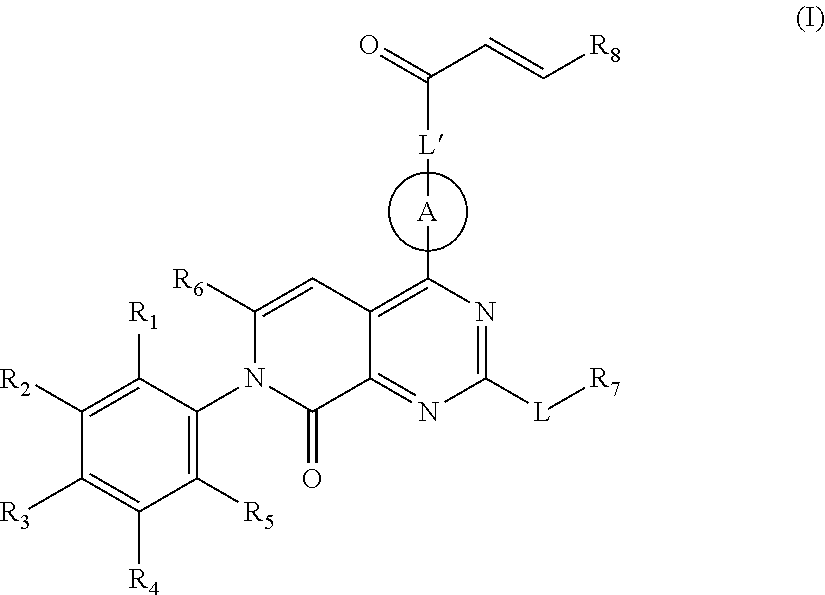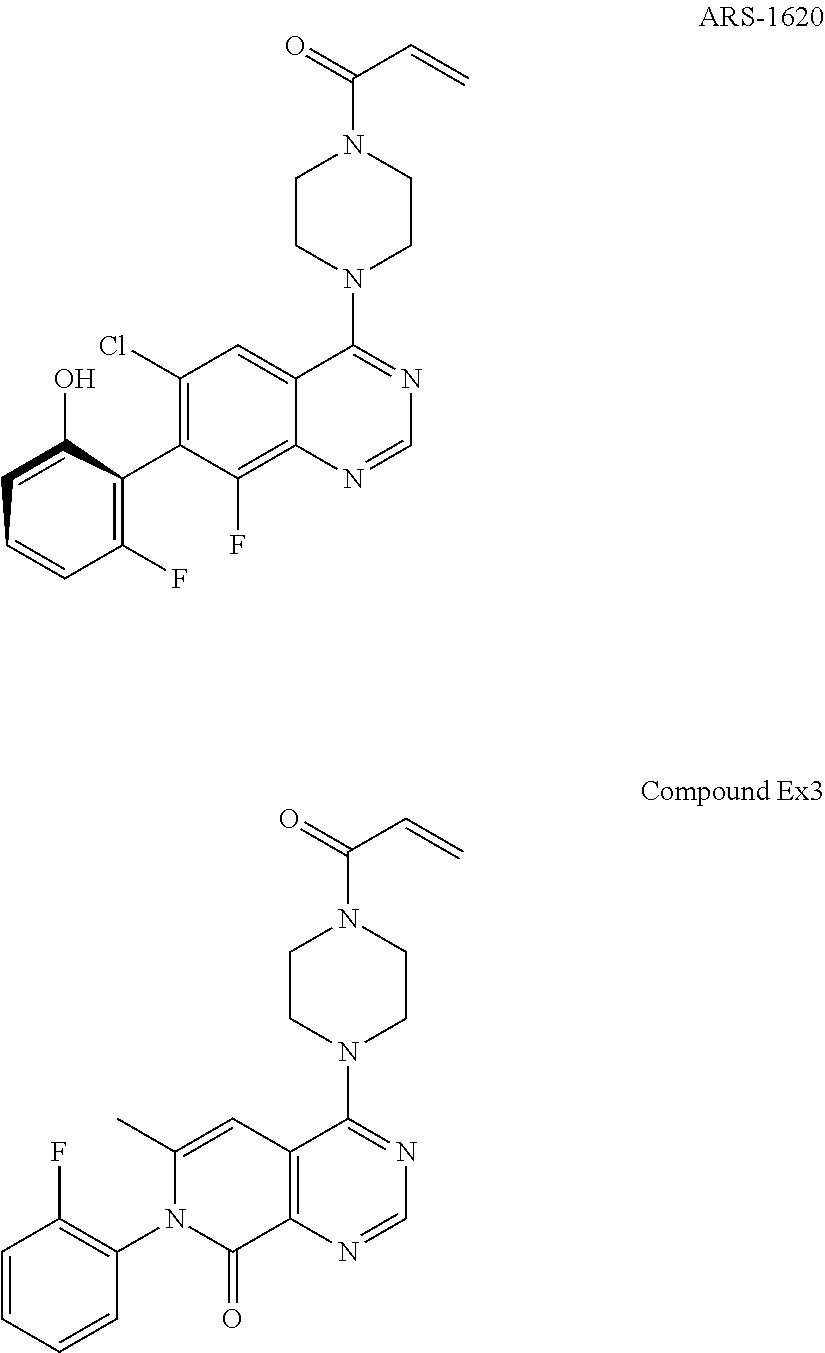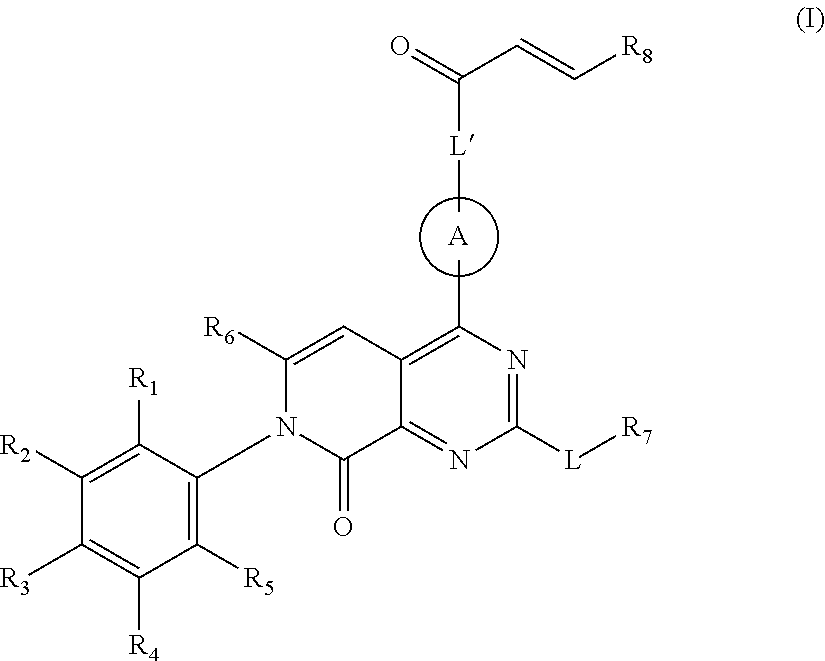Pyridone-pyrimidine derivative acting as krasg12c mutein inhibitor
a mutein inhibitor and pyrimidine technology, applied in the field of new substituted pyridonepyrimidine derivatives, can solve the problems of poor metabolic stability and difficult to further improve activity, and achieve the effects of strong selectivity, strong selectivity, and strong anti-proliferative activity
- Summary
- Abstract
- Description
- Claims
- Application Information
AI Technical Summary
Benefits of technology
Problems solved by technology
Method used
Image
Examples
example 1
[0132]
First Step:
[0133]Compound 1a (4.8 g, 28.34 mmol) was dissolved in ethyl acetate (10 mL), and palladium / carbon (500 mg, 10%) was added thereto under the protection of nitrogen. The reaction solution was subjected to replacement with hydrogen several times, and then stirred under a hydrogen balloon at 15° C. for 6 hours. The reaction mixture was filtered, and the filtrate was concentrated to obtain compound 1b. 1H NMR (400 MHz, CDCl3) δ 6.71-6.62 (m, 3H), 3.88 (s, 3H), 3.76 (brs, 2H).
Second Step:
[0134]The compound 1b (4.00 g, 28.34 mmol) and TEA (5.74 g, 56.68 mmol) were dissolved in DCM (50 mL), and methyl 3-chloro-3-oxopropionate (5.00 g, 36.62 mmol) was added dropwise thereto with stirring at 15° C. After the dropwise addition was completed, the reaction mixture was continued to be stirred at 15° C. for 5 minutes, and then diluted with DCM (50 mL). The reaction solution was washed respectively with 5% of diluted hydrochloric acid (50 mL) and saturated brine (50 mL), and the o...
example 2 and example 3
[0148]
First Step:
[0149]The compound 1j (18 g, 55.01 mmol) was dissolved in ionic liquid [HDBU+][TFE−] (30.44 g) at 25° C., and the reaction was carried out under a balloon filled with carbon dioxide gas for 12 hours, and then the reaction solution was poured into water (100 mL) and extracted with ethyl acetate (100 mL*3). The organic phases were combined, dried over anhydrous sodium sulfate, and concentrated under reduced pressure. The crude product was added to a mixed solvent of petroleum ether and ethyl acetate (petroleum ether:ethyl acetate=10:1; 15 mL), stirred and filtered. The filter cake was dried to obtain compound 2a. 1H NMR (400 MHz, DMSO-d6) δ 12.03-11.34 (m, 2H), 7.67-7.55 (m, 1H), 7.19 (s, 1H), 7.17-7.04 (m, 2H), 3.79 (s, 3H).
Second Step:
[0150]The compound 2a (11.4 g, 30.71 mmol) and pyridine hydrochloride (35.49 g, 307.08 mmol) were mixed, heated to 180° C. and reacted for 15 minutes, and then cooled. The reaction mixture was poured into saturated aqueous sodium bicar...
example 4
[0159]
First Step:
[0160]The 4-amino-1-methylpiperidine (38.98 mg, 341.34 μmol) was dissolved in DCM (3 mL), and TEA (51.81 mg, 512 μmol) and compound 2e (100 mg, 170.67 μmol) were added to this solution, and then stirred at 15° C. for 14 hours. The saturated aqueous ammonium chloride solution (20 mL) was added to the reaction solution to quench the reaction, and then extracted with ethyl acetate (20 mL*2). The organic phase was dried over anhydrous sodium sulfate and concentrated to obtain a crude product. The product was purified by preparative TLC (dichloromethane:methanol=10:1) to obtain compound 4a. 1H NMR (400 MHz, CDCl3) δ 7.28-7.19 (m, 1H), 7.06 (br s, 1H), 6.92 (s, 1H), 6.66-6.62 (m, 1H), 4.22-4.11 (m, 1H), 3.62-3.59 (m, 9H), 2.70 (s, 3H), 2.05-2.00 (m, 4H), 1.48 (s, 9H), 1.48-1.38 (m, 4H); LCMS (ESI) m / z: 621.9 (M+1).
Second Step:
[0161]The synthesis of compound 4b refers to that of compound 1o. LCMS (ESI) m / z: 522.3 (M+1).
Third Step:
[0162]The formate of example 4 was obtained...
PUM
| Property | Measurement | Unit |
|---|---|---|
| pH | aaaaa | aaaaa |
| pH | aaaaa | aaaaa |
| temperature | aaaaa | aaaaa |
Abstract
Description
Claims
Application Information
 Login to View More
Login to View More - R&D
- Intellectual Property
- Life Sciences
- Materials
- Tech Scout
- Unparalleled Data Quality
- Higher Quality Content
- 60% Fewer Hallucinations
Browse by: Latest US Patents, China's latest patents, Technical Efficacy Thesaurus, Application Domain, Technology Topic, Popular Technical Reports.
© 2025 PatSnap. All rights reserved.Legal|Privacy policy|Modern Slavery Act Transparency Statement|Sitemap|About US| Contact US: help@patsnap.com



